This piece is part of a series titled “Nonstate armed actors and illicit economies: What the Biden administration needs to know,” from Brookings’s Initiative on Nonstate Armed Actors.
Over the course of the post-Cold War period, the Western powers have made increasing, albeit uneven, efforts to respond to the challenge of fragile states. For all the weakness of Western and multilateral policy, those efforts have helped reduce the levels of violence in most regions. Now, though, there is serious and sustained competition for influence in fragile states, and over fragile states policy, which has become an arena for geopolitical competition. Not all of the actions of the West’s competitors, notably China, are malign; but many are, and the overall effect of viewing fragile states through a geopolitical lens is likely to erode that limited progress has been made on stability and responsive governance.
The old geopolitics
In the post-Cold War period, Western nations increasingly focused their attention on the plight of so-called fragile states. With the Cold War behind it, the U.N. began engaging in civil wars and protracted internal conflicts, predominantly in fragile states. Under the auspices of the Organisation for Economic Co-operation and Development (OECD), Western donors started re-orienting parts of their development portfolio towards addressing the plight of countries with fragile institutions and protracted political crises. Over time, organizations like the World Bank and the International Monetary Fund (IMF) saw a large increase in their support to countries torn by violence and stuck in poverty traps.
The United States was a laggard in this, until 9/11 drove a wholescale re-orientation of American policy towards countering terrorism, an approach that pulled it into deep engagement in the business of fragility in western Asia, the Middle East, and North Africa. Throughout, Western governments and multilateral institutions (then still wholly dominated by the West) struggled but strove to develop more coherent approaches to fragile states, ever more closely integrating security assistance, political and inter-group negotiations, support to national institutions, and humanitarian assistance.
Some parts of this agenda were successful; some parts failed. For two decades, wars in every region in the world declined, but in many cases sustained progress towards stable development proved challenging. Western governments, in the main, were slow to understand the long — even generational — timelines involved in transforming governance. The West also initially faced stiff resistance from elites in fragile states themselves, who viewed much of the peace-building agenda as intrusive on sovereignty. That evolved, however, as reformers within fragile states themselves began to organize and to work to influence policy within the multilateral institutions. The emergence of the Group of 7-Plus (G-7+) group of fragile states — an alliance of about 20 self-described fragile states in Asia, Africa, and Latin America — marked an important shift in the dynamics, and negotiations between the OECD and the G-7+ became a productive source of policy innovation. Elite resistance has not gone away, of course — and indeed, that’s part of what makes the changing geopolitical dynamics so problematic.
Throughout most of this period, the West had the field to itself. That is, Western nations dominated the interventions and investments in fragile states, and dominated the intervening institutions like the U.N. and the IMF. No longer. Now, the West has serious and sustained competition for influence in fragile states, and over fragile states policy, which have become an arena for geopolitical competition.
The new arena
The new dynamics include the rapid evolution of China’s role in fragile states, supported by considerable financing (in many countries, outstripping the largest Western donors) as well as diplomatic support. In some cases, the West now also confronts sustained efforts by Russia to counteract U.S. and European influence, as well as to generate profits for Russian enterprises. Regional powers have also increased their economic, diplomatic, and in some cases security actions in civil conflicts and in fragile states — witness Turkey’s new activism in the Horn of Africa, Turkey-Qatar-United Arab Emirates-Saudi competition for influence in Horn and North Africa, and Iran’s far-reaching role in Central Asia.
These “new” actors are often playing roles that Western nations don’t want to play (often for good reasons), like financing large infrastructure projects. They are rarely interested in following the approach that Western donors and the multilateral institutions have been trying to implement around governance reform (with some exceptions.)
The resulting competition represents particular risks for fragile states. These are particularly blatant across five areas:
- Major powers are more involved, directly or indirectly, in civil wars and political crisis, making their resolution much more complicated. Syria and Ukraine are good examples. Proxy wars, one of the great ills of the Cold War, are back with us.
- Investments and financial support from foreign interests in fragile states can undermine countries’ long-term economic and financial sustainability, such as in the Democratic Republic of Congo, Venezuela, and Zambia.
- Security arrangements and support can reduce the governance of the security and justice sector in fragile states, such as Russian support to security institutions in the Central African Republic and Venezuela, and Chinese engagement in Myanmar. (Of course, the U.S. is responsible for similar ills in some of its unilateral interventions in the broader Middle East.)
- Tensions at the U.N. Security Council and other global and regional institutions can reduce the international community’s ability to pressure local actors to prevent conflict from escalating and support more accountability in countries. The cases of Libya, Myanmar, Syria, and West Bank and Gaza are illustrative.
- In addition, ongoing tensions between the great powers and some of the regional powers will limit the bandwidth of Western countries to focus on fragile states as they refocus on higher strategic challenges.
The China and Russia challenges
China is the most consequential challenge. In some settings, its engagement has been pernicious, and inimical to good governance and to Western interests. For example, in Myanmar, China has (according to Burmese and Indian sources) provided financing to Arakan rebels and other militants in the region where China is building Belt and Road Initiative infrastructure and a planned new port facility. In Zambia, its non-transparent loans are eroding what limited progress has been made on governance reforms.
That said, the growing tendency in the U.S. to view everything that China touches with alarm has led some to overlook that in some countries, China has played a pragmatic role, especially in the economic arena. It played a constructive role in South Sudan’s peace talks, in the aid it has provided to the countries of the Mano River basin stricken by Ebola, and in its agreement to restructure its debt to many developing countries affected by COVID-19. More generally, when faced with pushback from regional governments and organizations, Beijing can at times be pressured to play a constructive role in fragile states. In other cases — where its security interests are more directly engaged, or when its investments in fragile states align with its effort to build out its network of ports and proto-bases — it’s played a more pernicious role. In such cases, the West will have to play hard ball, as it is has started to do in Zambia, with the IMF withholding financing until China becomes more transparent about its financing and investments in that country.
Russia is a very different case. Russia is looking for a market for its weapons industry and its “private” security firms, but it is also clearly trying to undermine the Western system of cooperation and embarrass the West when it can. It looks like it is set to be more proactive in fragile states and, contrary to China, is ready to get involved in active conflict when it suits its tactical interests. Unless Russia changes its attitude toward the West (unlikely), it will be very difficult to engage Russia more broadly on fragile states. On the other hand, Russia has very little economic and financial capacity to engage in another conflict at the level it did in Syria, and its economic footprint abroad cannot compare with China’s or Western nations. For fragile states, China counts much more than Russia.
What to do
Western policy can no longer ignore these new geopolitical realities in fragile states. As the West searches for coherent policy, it urgently needs to determine an effective approach to dealing with China, with Russian activism and disruption, and with some sub-regional powers like Turkey. Finding a common approach among Western governments will not be easy. In the U.S., the instinct will be to view fragile states as yet another domain for competition with China; in Europe, the instinct will be to find ways to engage China, and accommodate its growing role. What’s clear is this: If the West is divided, China will gain ever-more influence in these countries and in the multilateral institutions through which the response is usually organized.
The temptation in some Western capitals and international organizations will be to respond to China by closing their eyes, or worse, by allowing their own standards to fall in an effort to not be outplayed by China. That would be a mistake. The results would be a race-to-the-bottom dynamic that would generate economic and social crises, erode governance reforms, and along the way actually empower the most disruptive actors, like Russia.
Far better to do the hard work of finding common ground among Western donors and compete for high-standards influence against China, Russia, and others. China now outstrips even the United States in the scale of its investment in the developing world, but when the investments of the U.S., EU, Japan, and multilateral organizations are taken together, they substantially exceed Chinese flows. Civil society organizations, regional organizations, and reformer groups like the G-7+ can be allies in the search for high-standards development.
This will almost always work better if done in a practical way through in-country engagement, rather than aiming for general agreements at the global policy level. Europe has retained flexibility in dealing with some sets of nonstate actors that American policymakers are legally prohibited from dealing with; the EU tends to prioritize economic development over security assistance, while the U.S. is the reverse; and both Japan and India operate with a highly realist sense of their own interests. But while the U.S. tendency is to view multilateralism through the skewed lens of Afghanistan and post-invasion Iraq — both of which were outliers, not the norm, and both of which were examples where much U.S. policy actually added to fragility — there’s ample evidence from past experiences that the West can forge strategic coordination in its responses to fragile states.
That can be accomplished through a lead-nation arrangement, as in western Iraq during the Global Coalition to Defeat ISIS period; through a joint U.N.-NATO lead, as in Kosovo; through a multi-nation coalition, as in the Bosnia Peace Implementation Council; through regional organizations (like the African Union); or simply through strong support to national reformers (in Liberia, Sierra Leone, Timor Leste). Recent on-the-ground efforts to bring Indian, American, and Japanese development policy in Myanmar closer together, to resist China’s efforts, also show initial promise. Faced with a mounting challenge from non-Western powers, and growing demands on the foreign policy portfolio, both the economic and political rationale for prioritizing this coherence among like-minded partners is growing.
During the Cold War, superpower competition turned civil wars into proxy wars — which became some of the most brutal killing fields of modern history. The post-Cold War era saw major investments in security, development, and political strategies to end civil wars and foster somewhat stable development. The results were mixed, to be sure, but there was nonetheless a steady and sustained decline in levels of war in every region of the world, until the reversals of the Arab Spring. It would be a tragedy, and deeply shortsighted, if the system for peacebuilding and the efforts to address the root causes of fragility gave ground to a return to full-throated proxy war.
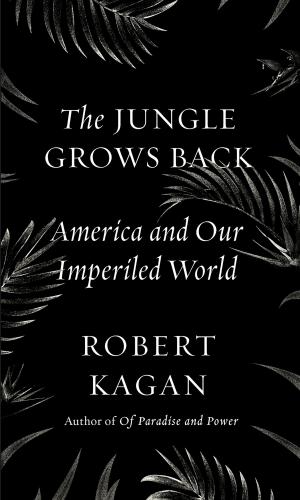
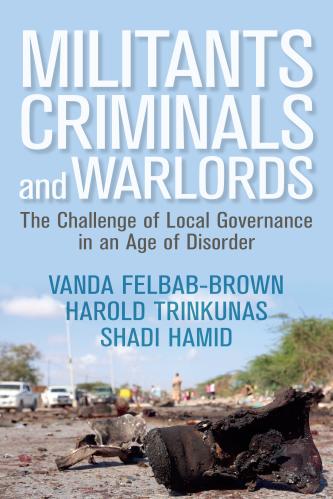
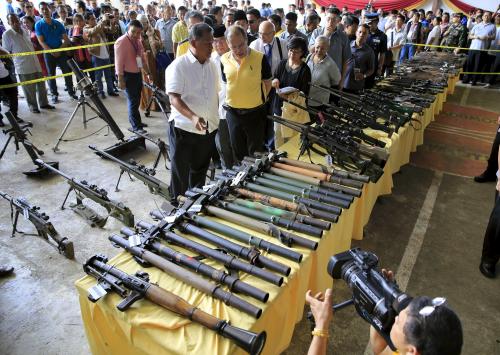
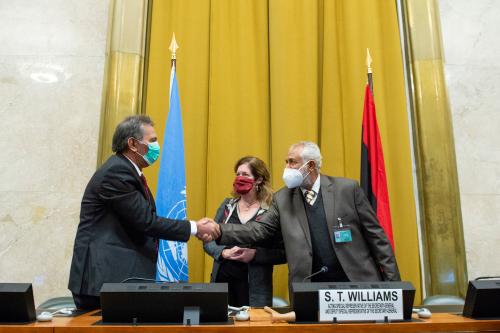
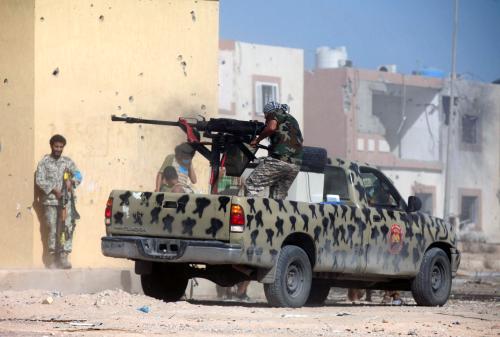





Commentary
The new geopolitics of state fragility
February 3, 2021